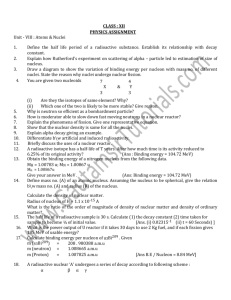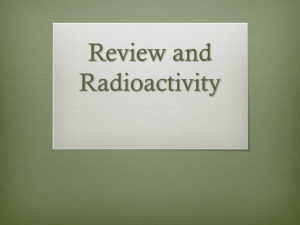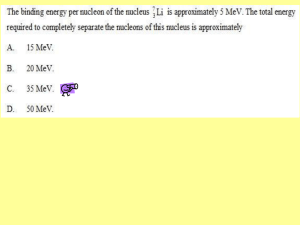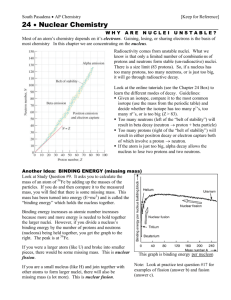Energy released in a decay
advertisement
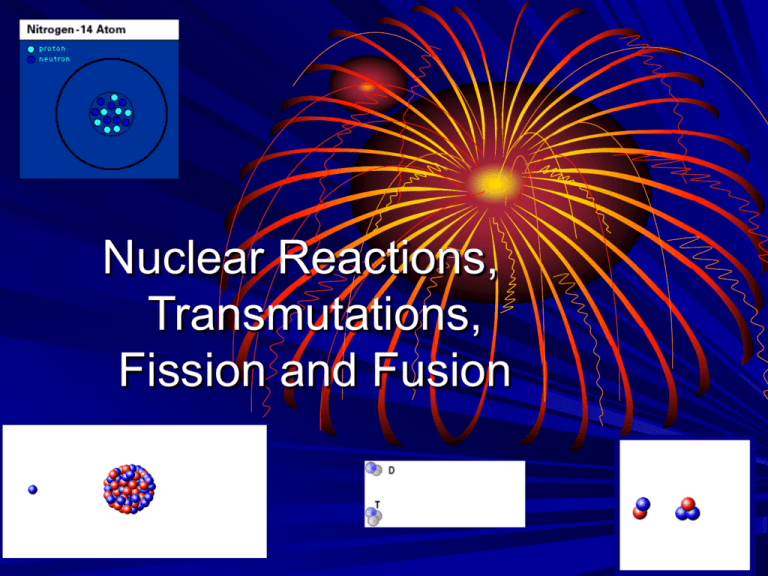
Nuclear Reactions, Transmutations, Fission and Fusion Natural transmutation (radioactivity) Till now we have discussed only transmutations of one nuclei to another by emmiting radioactive particle that occur only naturally. Induced (artificial) transmutation This change of one element to another through the bombardment of a nucleus is known as artificial transmutation. Induced transmutation doesn’t mean it can not happen naturally – it means bombarment only example: production of nitrogen from carbon in atmosphere or artificially induced in the lab 14 7 N 01n 146 C 11 p ● Alpha particle, neutrons, protons, and deuterons …. can be used to produce artificial nuclear reactions. ● The key to understanding these reactions and making predictions about the products of such reactions is being able to balance nuclear equations. ● For the nuclear equation : A → C + D or A + B → C + D ▪ nucleon and proton numbers must balance on each side of the equation. ▪ conservation of total energy (energy + mass) must be satisfied Energy released in nuclear reaction or decay is found the same way as binding energy: first find mass difference Δm = LHS – RHS in u and then E = Δm x 931.5 (MeV) Transmutations Examples Energy released in a decay: A → C + D spontaneous decay: M > m1 + m2 → binding energy of the decaying nucleus < binding energies of the product nuclei. The daughter is more stable. This is why radioactive decay happens with heavy elements lying to the right of maximum in the binding energy curve. Energy released is in the form of kinetic energy of the products. 226 88 Ra 222 86 Rn + 4 2 α M > m1 + m2 , but total energy on the left = total energy on the right Mc 2 = m1c 2 + m2 c 2 + KE1 + KE 2 a - decay Thorium – 228 decays by a – emission: Th 228 90 224 88 Ra a 4 2 Mass of thorium-228 nucleus = 227.97929 u Mass of radium-224 nucleus + a-particle = 223.97189 u + 4.00151 u = 227.97340 u Mass difference = 227.97929 u – 227.97340 u = 0.00589 u = 5.49 MeV What happens to this binding energy? It appears mostly as kinetic energy of a – particle. The radium nucleus also recoils slightly (and so momentum is conserved). b - decay Aluminum – 29 decays by b – emission: 29 13 Al Si + 29 14 0 -1 b+ Mass of aluminum-29 nucleus = 28.97330 u Mass of silicon-29 nucleus + b-particle + antineutrino = = 28.96880 u + 0.000549 u + 0 = 28.969349 u Mass difference = 28.97330 u – 28.969349 u = 0.003951 u = 3.68 MeV Again this becomes the kinetic energy of the decay products. Energy released in a nuclear reaction/artificial transmutation Nuclear reactions A + B → C + D can either 1. release energy if Δm = (mA + mB) – (mC + mD) > 0 The total amount of energy released will be E = Δmc2 in the form of kinetic energy of products. If there was initial kinetic energy, that will be added up to released energy. 2. or requires energy input Nitrogen-14 will decay only if energy is supplied to it – collision with fast moving α particle: 14 7 18.0057 u < 18.0070 u N 24a 178 O 11 p Δm = (m ) –Rutherford’s (mC + mD) induced <0 A + mB1. Famous transmutation: bombarding nitrogen gas α particle must have enough kinetic with energy to make up for imbalance in alpha particles from bismuth-214. masses, and to provide for kinetic energy of products. This energy is suplied by a particle accelerator used to accelerate the helium nucleus. Fission ● Fission means splitting up a large nucleus (A > 200) into two smaller nuclei. ● the total BE would increase which means that the daughters are more stable than parent. ● The excess energy is released by the reaction. ● Spontaneous fission is very rare. Uranium is the largest nucleus found on Earth. Its isotopes will sometimes fission naturally. But half-life for U-235 is 7.04x108 years ● Bombarding the nucleus with neutrons can trigger a fission reaction. ● For example The strong forces that hold the nucleus together only act over a very short distance. When a uranium nucleus absorbs a neutron it knocks the nucleus out of shape. If the nucleus deforms enough, the electrostatic repulsion between the protons in each half becomes greater than the strong force. It then splits in two. The nuclei splits randomly. In the diagram, the fission fragments are shown as isotopes of Ba and Kr. This is just one of the many possible combinations. Fission of a uranium nucleus gives out about 200 MeV of energy. Chain Reactions ● When the uranium nucleus splits, a number of neutrons are also ejected. ● If each ejected neutron causes another uranium nucleus to undergo fission, we get a chain reaction ● The number of fissions increases rapidly and a huge amount of energy is released. ● Uncontrolled chain reactions are used in nuclear bombs ● The energy they unleash is devastating. ● Nuclear power stations use the heat released in carefully controlled fission reactions to generate electricity. ● They use control rods to absorb some of the neutrons. Fusion ● Fusion means joining up two small nuclei to form a bigger nucleus. ● When two small nuclei the product of fusion would have more BE per nucleon. ● The increases in binding energy per nucleon are much larger for fusion than for fission reactions, because the graph increases more steeply for light nuclei. ● So fusion gives out more energy per nucleon involved in the reaction than fission. ● The stars are powered by fusion reactions. ● Each second, in our Sun, more than 560 million tonnes of hydrogen fuse together to make helium. ● One series of reactions for this is shown here: Each small nucleus has a positive charge so they will repel each other. To make the nuclei come close enough for the strong force to pull them together, they must be thrown together with very igh velocity. For this to take place, the matter must either be heated to temperatures as high as the core of the sun (about 13 million Kelvin) or the particles must be thrown together in a particle accelerator) ● The energy released is radiated by the Sun at a rate of 3.90 x 1020 MW. ● This is the power output of a million million million large power stations! ● Not surprisingly scientists are keen to develop fusion as a source of power (fusion reactor). ● One possible reaction is the fusion of deuterium and tritium. ● These are isotopes of hydrogen ● ● ● ● ● Fusion has a number of advantages over fission: greater power output per kilogram, the raw materials are cheap and readily available, no radioactive elements are produced directly, irradiation by the neutrons leads to radioactivity in the reactor materials but these have relatively short half lives and only need to be stored safely for a short time. ● So why don't we use fusion in nuclear power stations? ● The JET (Joint European Torus) project was set up to carry out research into fusion power. ● It has yet to generate a self-sustaining fusion reaction. ● The main problem is getting two nuclei close enough for long enough for them to fuse. ● Each small nucleus has a positive charge so they will repel each other. To make the nuclei come close enough for the strong force to pull them together, they must be thrown together with very igh velocity. For this to take place, the matter must either be heated to temperatures as high as the core of the sun (about 13 million Kelvin) or the particles must be thrown together in a particle accelerator) ● At this temperature all matter exists as an ionised gas or plasma. ● Problem: containment. What can you use to hold something this hot? ● JET (and Princeton) uses magnetic fields in a doughnutshaped chamber called a torus to keep the plasma away from the container walls. ● Unfortunately generating high temperatures and strong magnetic fields uses up more energy than the fusion reaction produces! ● The same problem is with accelerators, the path taken by Japan. ● We are still some years off a fusion power station. Applying the binding energy curve – checking stability For example consider the fission reaction Question: has the system become more stable? 238 92 U + 01n 90 38 Sr + 146 54 U + 3 01n total binding energy of U-238 = 7.6×238 = 1800 MeV total binding energy of Sr-90 = 8.7×90 = 780 MeV total binding energy of Xe-146 = 8.2×146 = 1200 MeV The sum of the total binding energies of the fission nuclei is greater than the binding energy of the uranium-238 nucleus. Effectively the system has become more stable by losing energy. (KEneutron provided that energy) Similarly for the fusion reaction 2 1 H + 31H 24 He + 01n the total binding energy of the helium nucleus is greater than the sum of binding energies of the tritium and deuterium nuclei. So, again as for fission, the system has effectively become more stable by losing energy. total binding energy of H-2 = 1×2 = 2 MeV total binding energy of H-3 = 2.8×3 = 8.4 MeV total binding energy of He-4 = 4×7 = 28 MeV The strong force does not actually occur directly between protons and neutrons in the nucleus, but in the smaller quarks making them up. The force is mediated by fundamental particles called gluons, named for the way they glue quarks together. Each proton or neutron is composed of three quarks. The strong nuclear force between nucleons is the result of the force holding together their constituent quarks. proton neutron nucleus electron

